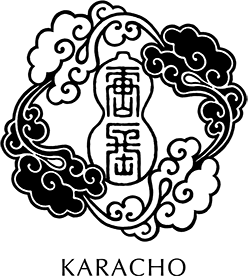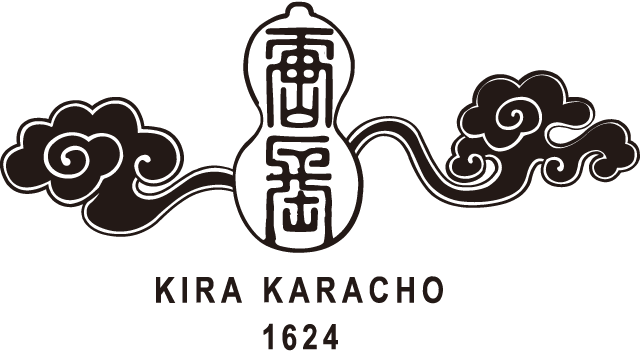Here is an introduction to the history and progress of Karacho/Kira Karacho.
The tumultuous 400-year history of Japan’s only continuous karakami makers, from 1624 to the present day.
Chronology of Karacho & Kirakaracho
- 1624
- While working as an imperial guard in Takeya-cho, Sakai-machi, the samurai Senda Choemon assisted in a karakami shop.
It is said that famous Japanese calligrapher Honami Koetsu built an art village in Takagamine, Kyoto and worked on karakami for use in his Saga Book.
From the second generation the family began to specialize in karakami. - 1679Death of the second master
- 1681Third master set up the studio in Higashinoto-in Rokkaku.
- 1687Death of the first master
- 1725Death of the third master
- 1742Death of the fourth master
- The fifth master faced many challenges in the Great Fire of Tenmei in 1788, but even despite the fire, he rebuilt the woodblocks and kept the family business going.
- 1791Woodblock with a pattern of the Kuyo seal publicized (following the Great Fire of Tenmei [1788], it is the oldest Karacho woodblock with a visible inscription on the back)
- 1807Death of the fifth master
- 1831In autumn of the 2nd year of Tempo, karakami appeared in publications from Santo Shorin
Mentioned as Honorable Karakami Artist Chouemon, Karakami-ya, Higashinoto-in Sanjosagaru.
The fact that the artist is the only one listed with the honorific “go” among several names, suggests that he worked for the imperial court and the shogunate. - 1832Death of the sixth master
- 1864The Hamaguri Gate Rebellion.
The seventh master went to great lengths to protect the woodblocks, resorting to filling a trough with water, placing them in the trough, and hiding them in a storehouse. - In 1864, the master successfully saved the woodblocks from being destroyed by gunfire during the Hamaguri Gate Rebellion, as Japan’s era of modernization under the Meiji Restoration dawned.
As people’s lifestyles changed with the civilization and enlightenment of the time, karakami was also lost, and many karakami makers went out of business. It is said that the Karacho master was so disillusioned about the future of karakami that he broke more than 200 woodblocks and burned them to heat his baths.
“They burn well; it is hell” (from the diary of the seventh master) - 1883Death of the seventh master
- 1895Featured at the "The 4th National Industrial Exhibition"
- Senda Hiroji Shoten store
- Senda Hiroji Shoten store1930Death of the eighth master
- The ninth master (an adopted son-in-law) took over the family business, but did not assume the family business name, calling it Senda Hiroji Shoten.
Thereafter, the name Senda Chouemon was never taken on during the Showa, Heisei, and Reiwa Eras (the three most recent eras, from 1926 to the present).
(Senda Hiroji Shoten) - Senda Paper Art
- Senda Paper Art1947Death of the ninth master
Senda Chojiro succeeded to the family business as the tenth master. (Senda Paper Art) - 1950The tenth master worked on the restoration of Katsura Imperial Villa
- 1959The tenth master worked to restore the Katsura Imperial Villa
- Karacho Co., Ltd.
- Karacho Co., Ltd.1970The tenth master moved the business to Shugakuin (Karacho Co., Ltd.)
- 1976Senda Kenkichi succeeded to become the 11th master.
- 1979The 11th master was involved in the restoration of Katsura Imperial Villa.
He participated in the restoration work as the person in charge of producing paulownia crest karakami for fusuma sliding doors and walls. - 1989The 11th master worked on the restoration of Nijo Castle
- 1993Senda Aiko opened a card store at the Shugakuin studio
- 1994The 11th master received the Japanese Traditional Culture Promotion Award
- 1996Death of the tenth master
- 1999Recognition of the 11th master as a Nationally Selected Conservation Technology Holder
- 2004Senda Aiko opens Kira Karacho store in Cocon Karasuma
- 2008Toto Akihiko’s karakami is born anew as art
- 2009The work "inochi (life)" was housed and exhibited at the MIHO MUSEUM.「inochi」
This was the first time in the history that karakami work had been housed in a museum as a piece of art. Written by Toto Akihiko and Senda Aiko - 2010Toto Akihiko was engaged in a two-year restoration of the karakami of Tawaraya Sotatsu’s “Matsuzu (Pine)”, an Important Cultural Property at Yogen-in (restoration in 2010, and again in 2011).
- 2010Toto Akihiko provided his karakami work of prayer, “Hoshi ni Negaiwo (Wish Upon a Star)” to Yogen-in Temple. This work, which stands alongside Tawaraya Sotatsu’s Important Cultural Property “Karajishi (Chinese Lion),” was the first karakami piece ever to be installed in a temple or shrine as a work of art.
- 2011Provided the work “Inochino Hikari (The Light of Life)” for the prayer hall of Go-o-jinja Shrine.(Written by Toto Akihiko and Senda Aiko )
- 2012The 11th master received the Order of the Rising Sun, Gold and Silver Rays
- Kira Karacho Co., Ltd.
- Kira Karacho Co., Ltd.2013Karacho Saruyama Salon in Gosho Nishi is renamed Atelier Kira Karacho (Kira Karacho Co., Ltd.)
- 2014Exhibition “The Beauty of Karakami: The World of Akihiko Toto, A Melody of Mica– A Moment in 400 Years” at Mitsuo Aida Museum of Art, Tokyo International Forum.
- 2016Supplied karakami to Sanjusangendo Temple of the Tendai Sect: Myoho-in Monzeki
- 2017Karakami artwork “Hoshi ni Negaiwo (Wish Upon a Star)” dedicated to Hakugenzan Ryusenji Temple, Hongwanji sect of Jodo Shinshu.
- 2018Moved to Saga
- A new atelier and guest house were built at a new location.
From then on, Kira Karacho, as the inheritor of Karacho culture in Saga, would pass on karakami to the next generation. - 2018Toto Akihiko received an award from Kyoto Mayor Daisaku Kadokawa for his contribution to the preservation and maintenance of cultural properties through the Murinan karakami work.
- 2018Beginning of the “Heisei Reiwa no Hyakumonyo (100 Patterns of Heisei and Reiwa) Project”
The Heisei Reiwa no Hyakumonyo project (100 Patterns of Heisei and Reiwa) aims to create a history of tradition and succession, as well as circulation and rebirth, by spreading karakami and Japanese culture. It seeks to be a sustainable cultural project that will be meaningful to Kyoto 100 years from now. - 2019Karakami provided for the front ceiling of the chapel of Muromachi Church of Christ in Japan
- 2020Toto Akihiko’s work “Universal Symphony” (Shinji Shumeikai Shoden, 020) was completed. In 2020, he began work on a karakami art piece based on the theme of praying for world peace. At 22 meters long, it is the largest piece of karakami art ever created.
- 2022Karacho Honten main studio moves to Saga, Kyoto.
- 2022Succeeding Senda Kenkichi the 11th master, Senda Aiko became the 13th head of Karacho.
Revitalization of the Karacho Logo - 2023MIHO MUSEUM Spring Special Exhibition “Bi no Inori (Prayer of Beauty)”
Toto Akihiko’s karakami artwork “Universal Symphony” will be exhibited.

